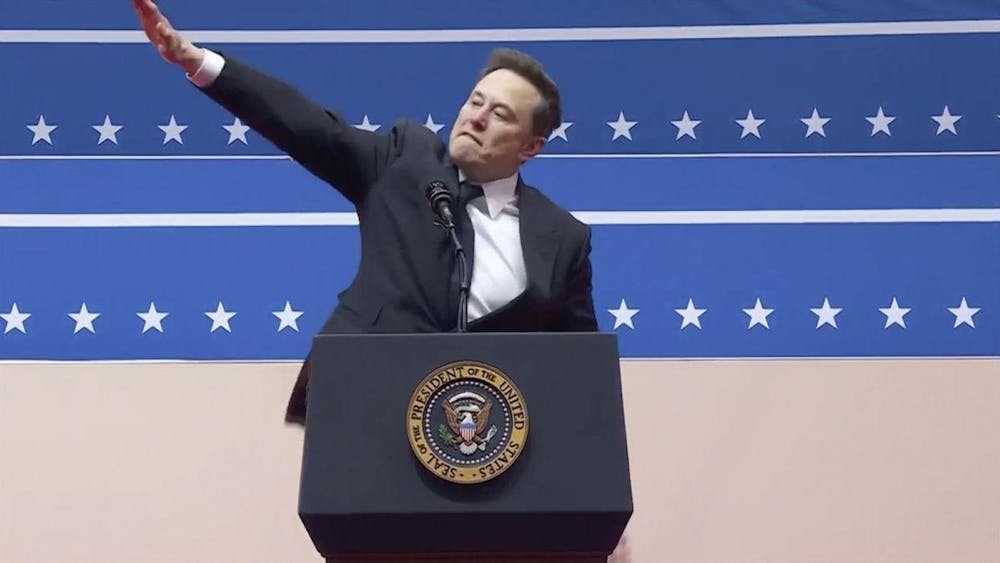During Trump’s inauguration, billionaire Elon Musk performed a salute that has sparked countless controversies, as people argue whether or not it was a Roman salute or Nazi salute. The question is: what exactly is a Roman salute?
The salute and people’s defenses
On Jan. 20, following a speech by Musk, the man performed a gesture before saying, “my heart goes out to you,” as seen in a video on The Hill’s website.
The gesture was a straight-armed salute with his hand outstretched and his palm facing down; he held this gesture for a few seconds both times that he did it.
Following the inauguration, on Jan. 23, he posted a series of puns using Nazi terms and the names of some Nazi elite, including Rudolf Hess, a deputy party leader; Joseph Goebbels, Nazi propagandist; Hermann Gőring, Gestapo creator; and Heinrich Himmler, who was in charge of racial extermination efforts during the Holocaust.
Puns included “Don’t say Hess to Nazi accusations,” “Some people will Goebbels anything down,” “Stop Gőring your enemies” and “Bet you did Nazi that coming.”
Throughout the last week, he has continued to post remarks about the Nazi party, as well as reposting videos of other political figures and pop star figures doing a similar salute, claiming that they are the same thing.
Debate has sparked as a result of his salute, with views split: some say that it is an obvious Nazi salute, and others claim that it was not. Those who say it was not have a variety of reasons, with the most popular being that it was actually a Roman salute.

However, many Americans who make this claim actually do not know the history of the Roman salute. Here is a brief history for those who may not be aware.
What exactly is the “Roman salute?”
Awad Halabi, a professor of history, provided a detailed explanation of the history of the Roman salute.
The salute was first used during the French Revolution by The National Assembly, who were inspired by a Roman painting.
“The salute gesture was understood to be the Roman salute, popularized by [Jacques-Louis David]’s The Oath of the Horatii, referring to a story from early Roman history,” Halabi said.
In the painting, “Oath of the Horatii,” three Roman brothers from the Horatii family extend one arm out towards their father, as a symbol that they are willing to sacrifice their life for the city they were defending.
Those viewing both versions of the salute– that being the Roman salute and Nazi salute– may notice that they are incredibly similar. This is because the Nazi salute was directly referenced from the Roman salute.
Before the Nazis decided to use it, however, the Italians borrowed it.
“Other admirers of [the Roman salute] were the Italian fascists, named after the Fasca, the bundle of reeds carried by Roman officials. They sought to imitate their glorious forerunners,” Halabi said.
Many European groups value ancient Greek art, culture and symbols. As a result, the Italians were the second after the French to take inspiration from the Greek painting.
In basic terms, the timeline of the salute is as follows: it was depicted in a Roman painting by Jacques-Louis David, though the salute did not have any historical or cultural standing in Rome outside of the painting; the Italian fascists adopted it; the Nazi regime adopted the salute and changed the name to the “Nazi salute;” and today, it still has political standing in some countries, but in particular fascist and Nazi/anti-semetic regimes.
The Roman salute continues to thrive in fascists in Italy; in fact, in honor of Italian Dictator of Fascist Italy, Benito Mussolini’s execution anniversary, some Italians were shown to do the Roman salute.
There are many ways in modern culture to acknowledge a crowd or portray a positive message. Performing this salute– no matter if it was meant to be the Roman or Nazi, or even Italian fascist salute– has a negative connotation for those who wish for the U.S. to remain a diverse democracy.
Elon Musk’s views
A professor at Wright State University brought awareness to some of the beliefs and claims of both Musk and President Donald Trump.
“[This] suspicion might be justified. Elon has posted [that] the AFD, a right-wing group in Germany, is the best hope for Germany. He is also supporting a right-wing group in England. You might [also] remember that Donald Trump told the Proud Boys to be ready, while he was president,” the professor said.
Articles from Fortune, DW, and The New York Times all have published articles talking about these topics. While Trump’s remark to tell the Proud Boys to “be ready” is a few years old, Musk’s political views are incredibly recent, with both articles being published within the past week.
Unfortunately, their support of fascist and extreme right-wing groups continue to show what the true meaning of Musk’s salute may have been.











